Mutual Coupling Effect and Reduction Method with Modified Electromagnetic Band Gap in UWB MIMO Antenna
Abstract
:1. Introduction
- We propose an improved mutual coupling reduction method that achieves a relatively high isolation of −23 dB that covers a broadband of frequencies.
- The MC reduction method was designed in a way that we achieved a small antenna size 19 × 24 mm2 when compared to previous studies.
2. UWB Patch Antenna Design
2.1. Geometric Structure
2.2. The Flow Chart of the Proposed Approach
2.3. Design Equations
2.4. Introducing EBG Structure into the Patch Antenna
3. MIMO UWB Antenna
3.1. Antenna Array without MEBG
3.2. Antenna Array with MEBG
| Distance (d) | Legend | Mutual Coupling (S12) |
|---|---|---|
| 34 |  | −18.73 |
| 44 |  | −19.45 |
| 54 |  | −22.59 |
| 64 |  | −23.38 |
| 74 |  | −23.49 |
4. Results and Discussions
4.1. Antenna Gain and VSWR
4.2. The S-Parameter
4.3. Current Distribution
4.4. Radiation Pattern
4.5. Diversity Performance
4.6. Result Validation
5. Comparative Analysis
6. Conclusions
Author Contributions
Funding
Institutional Review Board Statement
Informed Consent Statement
Data Availability Statement
Conflicts of Interest
References
- Saxena, S.; Kanaujia, B.K.; Dwari, S.; Kumar, S.; Tiwari, R. A compact dual-polarized MIMO antenna with distinct diversity performance for UWB applications. IEEE Antennas Wirel. Propag. Lett. 2017, 16, 3096–3099. [Google Scholar] [CrossRef]
- Wang, D.; Yoo, S.; Cho, S.H. Experimental comparison of IR-UWB radar and FMCW radar for vital signs. Sensors 2020, 20, 6695. [Google Scholar] [CrossRef] [PubMed]
- Zhang, X.; Yang, X.; Ding, Y.; Wang, Y.; Zhou, J.; Zhang, L. Contactless simultaneous breathing and heart rate detections in physical activity using IR-UWB radars. Sensors 2021, 21, 5503. [Google Scholar] [CrossRef] [PubMed]
- Abbas, A.; Hussain, N.; Lee, J.; Park, S.G.; Kim, N. Triple rectangular notch UWB antenna using EBG and SRR. IEEE Access 2020, 9, 2508–2515. [Google Scholar] [CrossRef]
- Li, J.F.; Chu, Q.X.; Li, Z.H.; Xia, X.X. Compact dual band-notched UWB MIMO antenna with high isolation. IEEE Trans. Antennas Propag. 2013, 61, 4759–4766. [Google Scholar] [CrossRef]
- Mchbal, A.; Touhami, N.A.; Elftouh, H.; Dkiouak, A. Mutual coupling reduction using a protruded ground branch structure in a compact UWB owl-shaped MIMO antenna. Int. J. Antennas Propag. 2018, 2018, 4598527. [Google Scholar] [CrossRef] [Green Version]
- Abd El-Hameed, A.S.; Wahab, M.G.; Elshafey, N.A.; Elpeltagy, M.S. Quad-port UWB MIMO antenna based on LPF with vast rejection band. AEU Int. J. Electron. Commun. 2021, 134, 153712. [Google Scholar] [CrossRef]
- Mohanty, A.; Behera, B.R. Characteristics mode analysis: A review of its concepts, recent trends, state-of-the-art developments and its interpretation with a fractal UWB MIMO antenna. Prog. Electromagn. Res. B 2021, 92, 19–45. [Google Scholar] [CrossRef]
- Arumugam, S.; Manoharan, S.; Palaniswamy, S.K.; Kumar, S. Design and performance analysis of a compact quad-element UWB MIMO antenna for automotive communications. Electronics 2021, 10, 2184. [Google Scholar] [CrossRef]
- Dey, A.B.; Pattanayak, S.S.; Mitra, D.; Arif, W. Investigation and design of enhanced decoupled UWB MIMO antenna for wearable applications. Microw. Opt. Technol. Lett. 2021, 63, 845–861. [Google Scholar] [CrossRef]
- Yang, L.; Li, T.; Yan, S. Highly compact MIMO antenna system for LTE/ISM applications. Int. J. Antennas Propag. 2015, 2015, 714817. [Google Scholar] [CrossRef] [Green Version]
- Soltani, S.; Murch, R.D. A compact planar printed MIMO antenna design. IEEE Trans. Antennas Propag. 2015, 63, 1140–1149. [Google Scholar] [CrossRef]
- Diman, A.A.; Karami, F.; Rezaei, P.; Amn-e-Elahi, A.; Mousavirazi, Z.; Denidni, T.A.; Kishk, A.A. Efficient SIW-feed network suppressing mutual coupling of slot antenna array. IEEE Trans. Antennas Propag. 2021, 69, 6058–6063. [Google Scholar] [CrossRef]
- Reddy, M.H.; Sheela, D.; Parbot, V.K.; Sharma, A. A compact metamaterial inspired UWB-MIMO fractal antenna with reduced MC. Microsyst. Technol. 2021, 27, 1971–1983. [Google Scholar] [CrossRef]
- Abbas, A.; Hussain, N.; Sufian, M.A.; Jung, J.; Park, S.M.; Kim, N. Isolation and gain improvement of a rectangular notch UWB-MIMO antenna. Sensors 2022, 22, 1460. [Google Scholar] [CrossRef]
- Altaf, A.; Iqbal, A.; Smida, A.; Smida, J.; Althuwayb, A.A.; Hassan Kiani, S.; Alibakhshikenari, M.; Falcone, F.; Limiti, E. Isolation improvement in UWB-MIMO antenna system using slotted stub. Electronics 2020, 9, 1582. [Google Scholar] [CrossRef]
- Kayabasi, A.; Toktas, A.; Yigit, E.; Sabanci, K. Triangular quard-port multi-polarized UWB MIMO antenna with enhanced isolation using neutralization ring. AEU-Int. J. Electron. Commun. 2018, 85, 47–53. [Google Scholar] [CrossRef]
- Najam, A.I.; Duroc, Y.; Tedjini, S. UWB-MIMO antenna with novel stub structure. Prog. Electromagn. Res. C 2011, 19, 245–257. [Google Scholar] [CrossRef] [Green Version]
- Kahng, S.; Shin, E.C.; Jang, G.H.; Anguera, J.; Ju, J.H.; Choi, J. A UWB antenna combined with the CRLH metamaterial UWB bandpass filter having the bandstop at the 5 GHz-band WLAN. In Proceedings of the IEEE Antennas and Propagation Society International Symposium, Charleston, SC, USA, 1–5 June 2009; pp. 1–4. [Google Scholar]
- Amjad, I.; Saraereh, O.A.; Ahmad, A.W.; Bashir, S. MC reduction using f-shaped stubs in UWB-MIMO antenna. IEEE Access 2017, 6, 2755–2759. [Google Scholar]
- Fan, Y.; Yahya, R.S. Microstrip antennas integrated with electromagnetic band-gap (EBG) structures: A low MC design for array applications. IEEE Trans. Antennas Propag. 2003, 51, 2936–2946. [Google Scholar]
- Su, Y.; Xing, L.; Cheng, Z.Z.; Ding, J.; Guo, C.J. Mutual coupling reduction in microstrip antennas by using dual layer uniplanar compact EBG (UCEBG) structure. In Proceedings of the International Conference on Microwave and Millimeter Wave Technology, Chengdu, China, 8–11 May 2010; pp. 180–183. [Google Scholar]
- Malekpour, N.; Honarvar, M.A. Design of high-isolation compact MIMO antenna for UWB application. Prog. Electromagn. Res. 2016, 62, 119–129. [Google Scholar] [CrossRef] [Green Version]
- Wu, L.; Xia, Y.; Cao, X. Design of compact quad-band notched UWB-MIMO antenna. Wirel. Pers. Commun. 2018, 98, 225–236. [Google Scholar] [CrossRef]
- Naser, S.A.; Dib, N.I. A compact printed UWB Pacmanshaped MIMO antenna with two frequency rejection bands. Jordanian J. Comput. Inf. Technol. 2016, 2, 1–16. [Google Scholar]
- Jetti, C.R.; Nandanavanam, V.R. Trident-shape strip loaded dual band-notched UWB MIMO antenna for portable device applications. AEU Int. J. Electron. Commun. 2018, 83, 11–21. [Google Scholar] [CrossRef]
- Babu, K.V.; Anuradha, B. Design of UWB MIMO antenna to reduce the mutual coupling using defected ground structure. Wirel. Pers. Commun. 2021, 118, 3469–3484. [Google Scholar] [CrossRef]
- Hasan, M.N.; Chu, S.; Bashir, S. A DGS monopole antenna loaded with U-shape stub for UWB MIMO applications. Microw. Opt. Technol. Lett. 2019, 61, 2141–2149. [Google Scholar] [CrossRef]
- Saurabh, A.K.; Meshram, M.K. Compact sub-6 GHz 5G-multiple-input-multiple-output antenna system with enhanced isolation. Int. J. RF Microw. Comput. Aided Eng. 2020, 30, 1–11. [Google Scholar] [CrossRef]
- Dabas, T.; Gangwar, D.; Kanaujia, B.K.; Gautam, A.K. Mutual coupling reduction between elements of UWB MIMO antenna using small size uniplanar EBG exhibiting multiple stop bands. AEU-Int. J. Electron. Commun. 2018, 93, 32–38. [Google Scholar] [CrossRef]
- Mansoul, A.; Nedil, M. Mutual Coupling Reduction for UWB MIMO Antenna with High Frequencies Rejection. In Proceedings of the 2020 IEEE International Symposium on Antennas and Propagation and North American Radio Science Meeting, Montreal, Quebec, Canada, 5–10 July 2010; pp. 1965–1966. [Google Scholar]
- Prabhu, P.; Malarvizhi, S. Novel double-side EBG based mutual coupling reduction for compact quad port UWB MIMO antenna. AEU-Int. J. Electron. Commun. 2019, 109, 146–156. [Google Scholar] [CrossRef]
- Urimubenshi, F.; Konditi, D.B.; de Dieu Iyakaremye, J.; Mpele, P.M.; Munyaneza, A. A novel approach for low mutual coupling and ultra-compact Two Port MIMO antenna development for UWB wireless application. Heliyon 2022, 8, 2–13. [Google Scholar] [CrossRef]
- Qurratul, A.; Neela, C. Parametric study and analysis of band stop characteristics for a compact UWB antenna with tri-band notches. J. Microw. Optoelectron. Electromagn. Appl. 2018, 17, 509–527. [Google Scholar]
- Fadehan, G.; Adedeji, K.B.; Olasoji, Y.O. Parametric study and analysis of modified electromagnetic band gap in frequency notching of ultra-wide band antenna. Int. J. Eng. Res. Afr. 2022, 61, 151–164. [Google Scholar] [CrossRef]
- Mohamad, K.A.R. Electromagnetic Band Gap (EBG) Structure in Microwave Device Design. Master’s Thesis, Department of Electrical Engineering, University of Technology, Johor Bahru, Malaysia, 2008. [Google Scholar]
- Naveen, J.; Kanaujia, B.K.; Gupta, S.D.; Srivastava, S. Triple band notched UWB antenna design using electromagnetic band gap structures. Prog. Electromagn. Res. C 2016, 66, 139–147. [Google Scholar]
- Osama, A.; Abdel-Razik, S. Mutual coupling effect on ultrawideband linear antenna array performance. Int. J. Antennas Propag. 2011, 2011, 142581. [Google Scholar]
- Kaabal, A.; Mustapha, E.H.; Saida, A.; Adel, A. A low mutual coupling design for array microstrip antennas integrated with electromagnetic band-gap structures. In Proceedings of the 9th International Conference Interdisciplinary in Engineering, Tirgu-Mures, Romania, 8–9 October 2015. [Google Scholar]
- Liu, L.S.; Cheung, S.W.; Yuk, T.I. Compact MIMO antenna for portable devices in UWB applications. IEEE Trans. Antennas Propag. 2013, 61, 4257–4264. [Google Scholar] [CrossRef] [Green Version]
- Sara, S.; Es-salhi, A.; Elhitmy, M. Reduction of mutual coupling between radiating elements of an array antenna using EBG electromagnetic band structures. Int. J. Electr. Electron. Eng. Telecommun. 2020, 10, 91–98. [Google Scholar]
- Kudumu, V.P.; Makkapati, V.S.P. Mutual coupling reduction between slotted-T MIMO elements for UWB applications. Prog. Electromagn. Res. C 2021, 107, 203–217. [Google Scholar]
- Awais, K.; Bashir, S.; Ghafoor, S.; Qureshi, K.K. Mutual coupling reduction using ground stub and EBG in a compact wideband MIMO-antenna. IEEE Access 2021, 9, 40972–40979. [Google Scholar]
- Mohamadzade, B.; Lalbakhsh, A.; Simorangkir, B.V.; Rezaee, A.; Hashmi, M.R. MC reduction in microstrip array antenna by employing cut side patches and EBG structures. Prog. Electromagn. Res. M 2020, 89, 179–187. [Google Scholar] [CrossRef]
- Jabire, A.H.; Abdu, A.; Saminu, S.; Salisu, S.; Sadiq, A.M.; Jajere, A.M.; Ahmed, Y.K. Reduction of mutual coupling in UWB/MIMO antenna using stub loading technique. J. Electr. Control Commun. Eng. 2021, 17, 1–12. [Google Scholar] [CrossRef]
- Alsayaghi, A.; Sabapathy, T.; Jusoh, M.; Hossain, K.; Ahmad, R.B.; Osman, M.N.; Jayaprakasam, S.; Rahim, H.A.; Raghava, N.S. Investigation on the mutual coupling reduction in MIMO antenna using dual split CSRR EBG. In Proceedings of the 1st International Conference on Engineering and Technology, Arau, Malaysia, 15–16 March 2021. [Google Scholar]

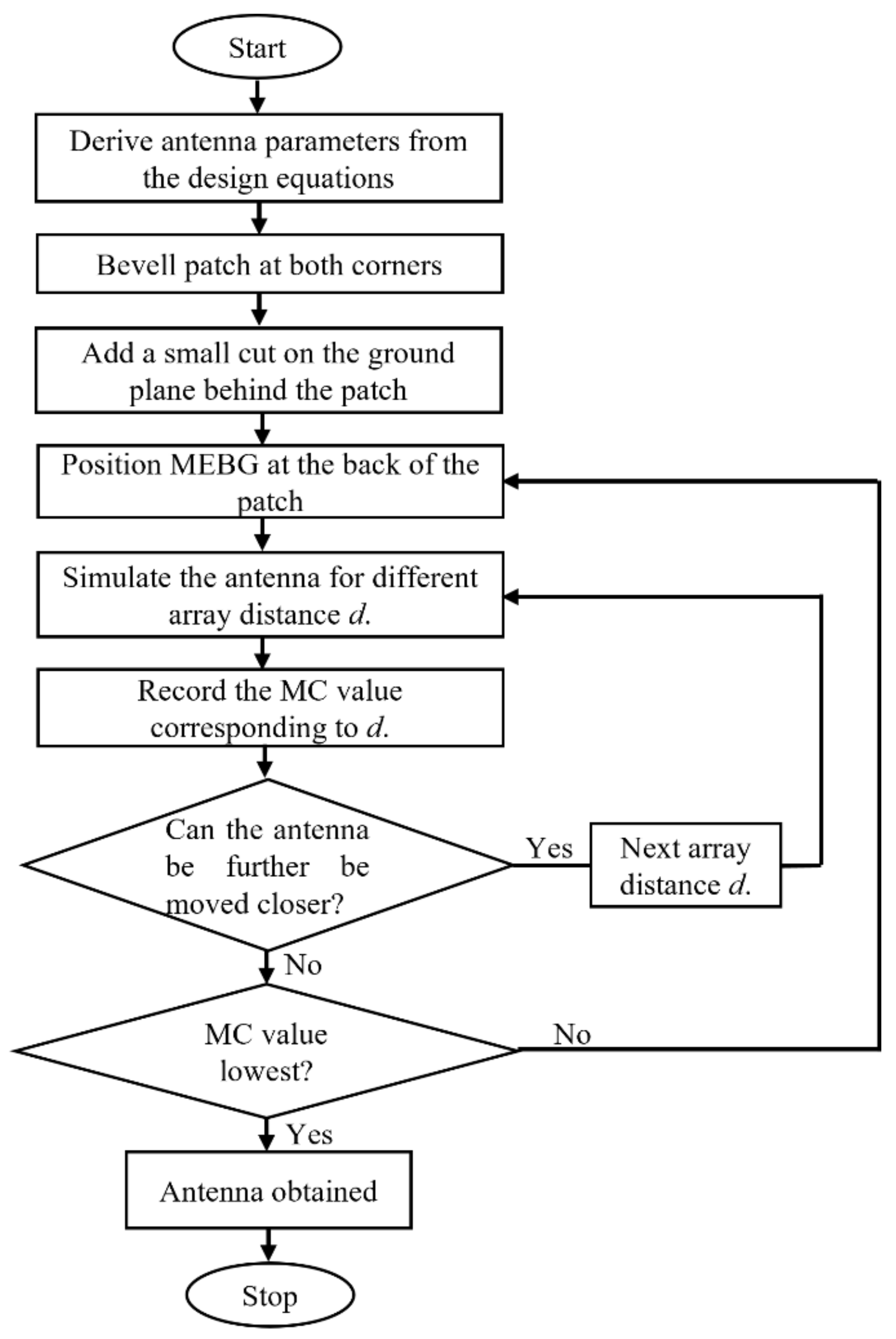



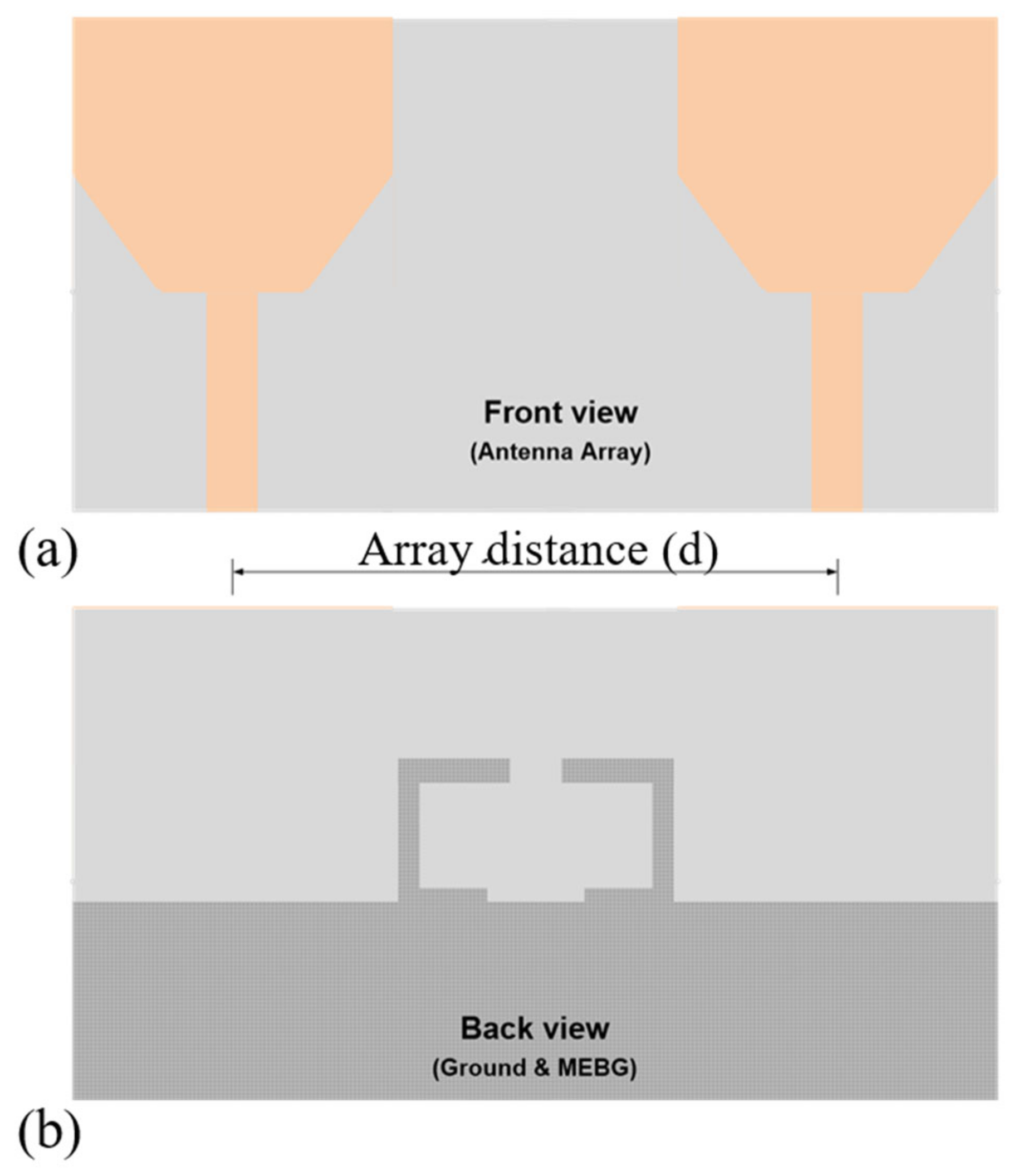
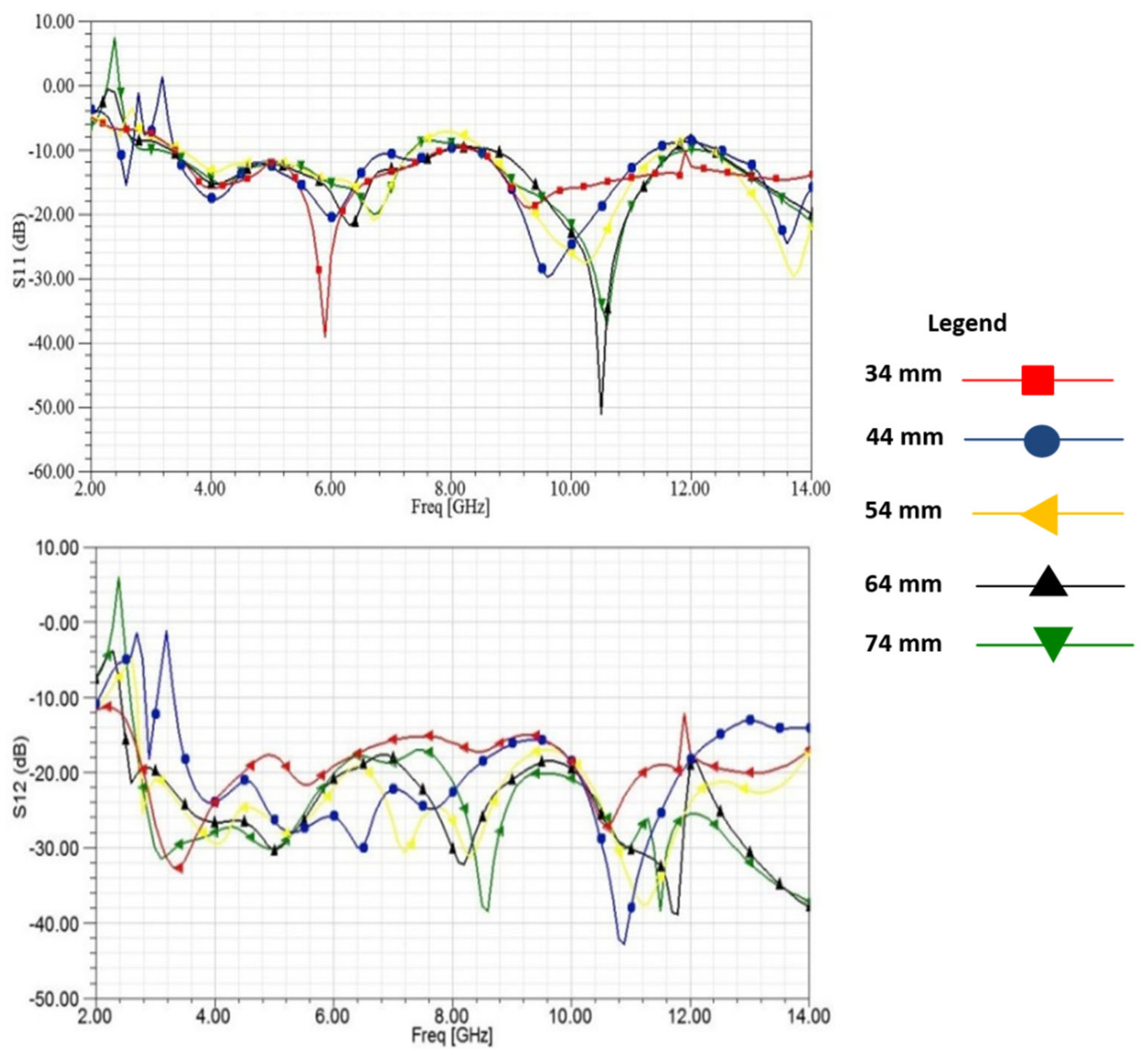
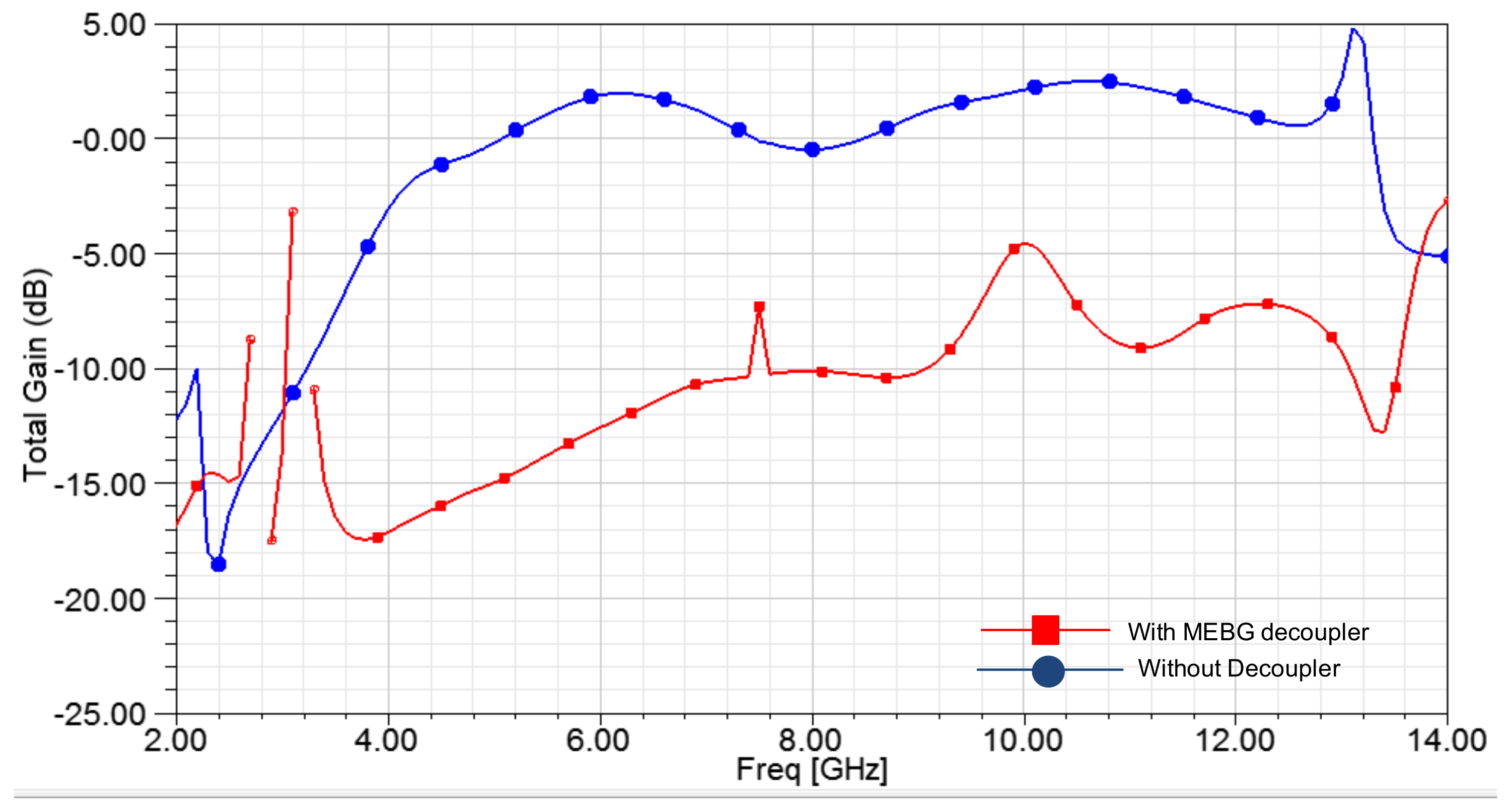
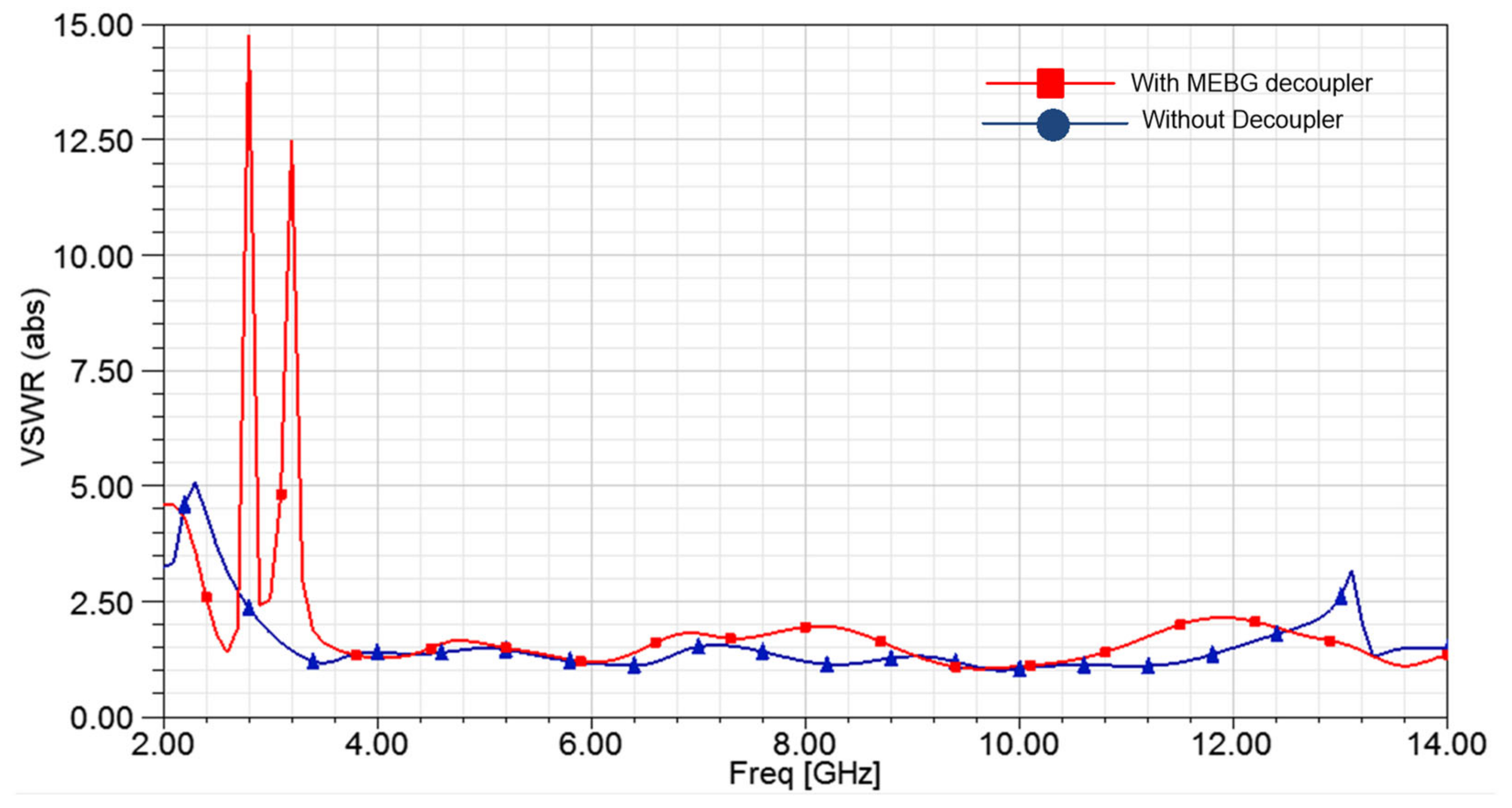



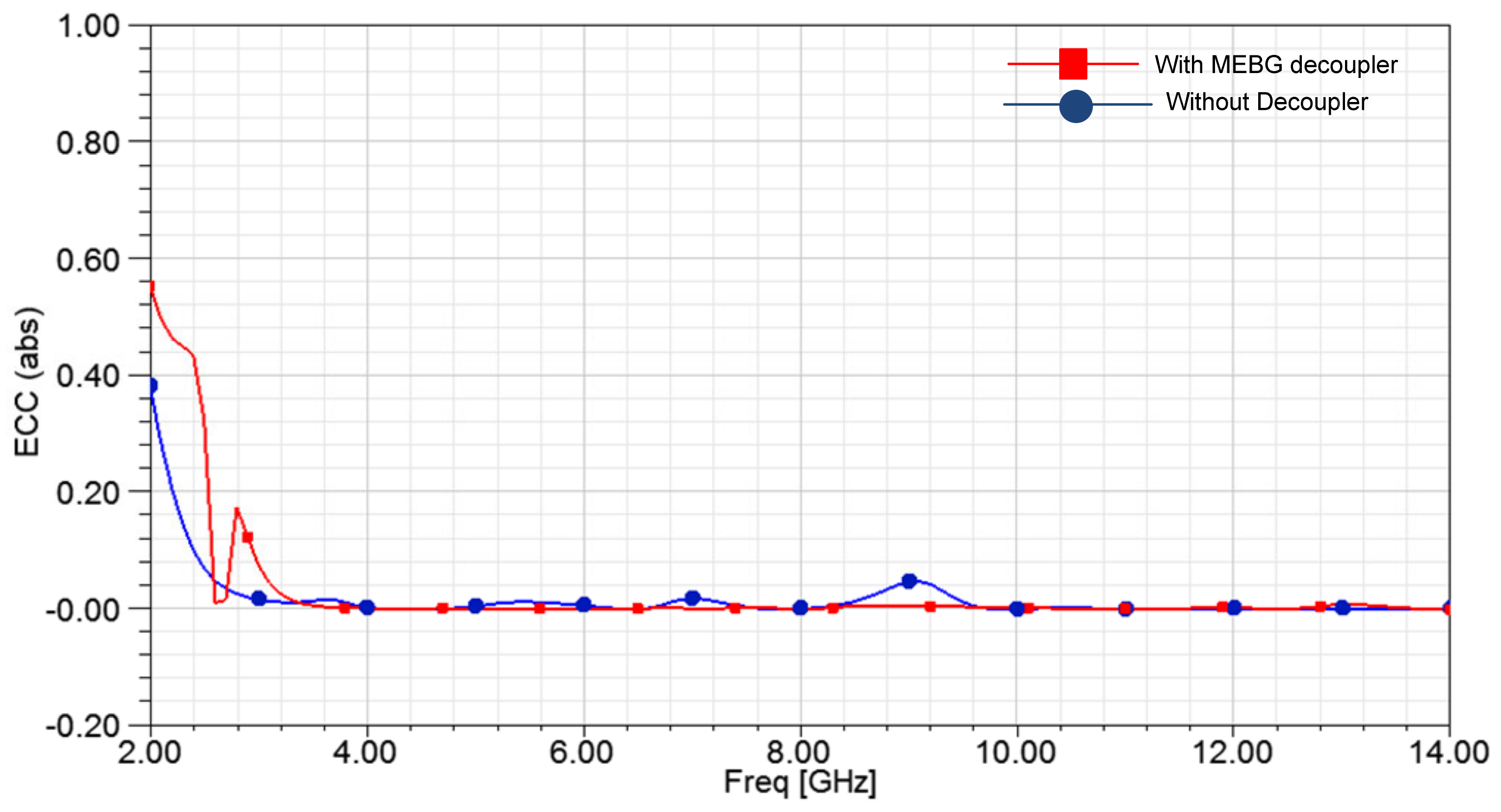

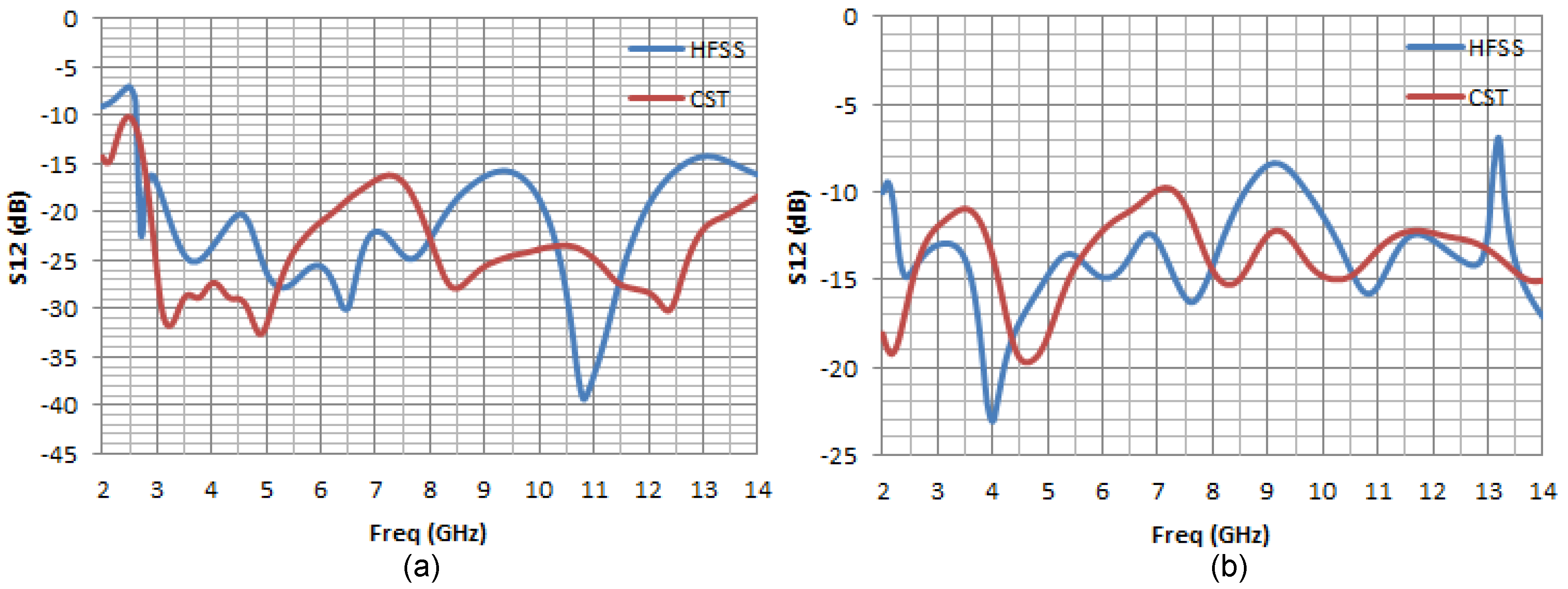
| Parameter | L | W | L1 | L2 | L3 | L4 | W1 | W2 |
|---|---|---|---|---|---|---|---|---|
| Dimension | 31.0 | 24.0 | 17.7 | 0.5 | 11.5 | 1.5 | 10.25 | 3.3 |
| Distance (d) (mm) | Legend | MC (S12) |
|---|---|---|
| 34 |  | −12.40 |
| 44 |  | −13.52 |
| 54 |  | −14.59 |
| 64 |  | −15.14 |
| 74 |  | −16.62 |
| Authors | Antenna Type and Design | MC | Operating Frequency | Impedance Bandwidth |
|---|---|---|---|---|
| [39] | A mushroom-like EBG was employed for suppression between two rectangular UWB MIMO antenna. | −23 dB | 5.8 GHz | NA |
| [40] | Two long protruding ground stubs were added to the ground plane of a compact MIMO-UWB planar monopole antenna for MC reduction. | −15 dB | NA | 3.1–10.6 GHz |
| [41] | Array antenna with EBG with High Impedance Surface (SHI) structure for MC reduction for WiMAX system. | −10 dB | 3.5 GHz | 3.3–3.7 GHz |
| [42] | A T-shaped ground stub and a slot were employed for MC reduction in a MIMO antenna with a strip-line was used as the feed. | −20 dB | 6.85 GHz | 3.1–10.6 GHz |
| [43] | A compact Uni-planar MIMO antenna with partial ground stub and a single column EBG structure for MC reduction was investigated. | −25 dB | NA | 3.1–11 GHz |
| [44] | A Minkowski fractal geometry with four EBG elements between the antenna array was utilized for MC reduction | −22 dB | 5.6 GHz | 3.1–10.6 GHz |
| [45] | Stub loading technique for MC reduction between UWB-MIMO antenna elements was presented. | −20 dB | 5.8 GHz | 2.6–12 GHz |
| [46] | A dual split CSRR EBG was utilized for MC reduction in rectangular inset feed MIMO. antenna | −18.8 dB | 2.45 GHz | 3.1–10.6 GHz |
| Current study | A Modified EBG was used with beveled rectangular radiating MIMO antenna. | −23 dB | 6.85 GHz | 3.1–13.5 GHz |
Publisher’s Note: MDPI stays neutral with regard to jurisdictional claims in published maps and institutional affiliations. |
© 2022 by the authors. Licensee MDPI, Basel, Switzerland. This article is an open access article distributed under the terms and conditions of the Creative Commons Attribution (CC BY) license (https://creativecommons.org/licenses/by/4.0/).
Share and Cite
Fadehan, G.A.; Olasoji, Y.O.; Adedeji, K.B. Mutual Coupling Effect and Reduction Method with Modified Electromagnetic Band Gap in UWB MIMO Antenna. Appl. Sci. 2022, 12, 12358. https://doi.org/10.3390/app122312358
Fadehan GA, Olasoji YO, Adedeji KB. Mutual Coupling Effect and Reduction Method with Modified Electromagnetic Band Gap in UWB MIMO Antenna. Applied Sciences. 2022; 12(23):12358. https://doi.org/10.3390/app122312358
Chicago/Turabian StyleFadehan, Gabriel A., Yekeen O. Olasoji, and Kazeem B. Adedeji. 2022. "Mutual Coupling Effect and Reduction Method with Modified Electromagnetic Band Gap in UWB MIMO Antenna" Applied Sciences 12, no. 23: 12358. https://doi.org/10.3390/app122312358





